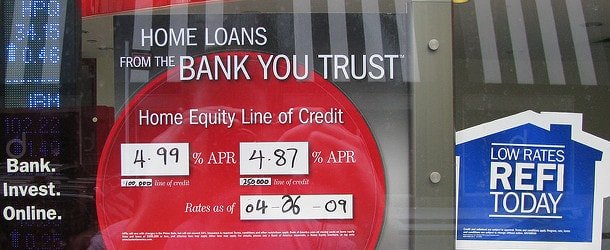Recently, homeowners have turned to their home equity for their cash needs.
After all, most people already have a super low fixed mortgage rate and don’t want to disturb it in any way.
If they were to go the cashout refinance route, they would lose their old low interest rate and end up with a much higher one.
To avoid this, they can instead take out a second mortgage and keep the existing first mortgage intact.
The question is: Do you go with a HELOC or a home equity loan?
How HELOCs and home equity loans are alike
If you are like many people trying to understand the difference between a home equity line of credit (HELOC) and a home equity loan, allow me to help.
There are basically three main differences between the two, despite both options sharing many of the same qualities. Let’s discuss them first before getting into their differences.
First, they both often act as a second mortgage. And they both give you the opportunity to utilize your home equity.
You can get cash from both, and you can do it without disrupting your first mortgage.
Nothing changes with your first mortgage when you take out a second mortgage like a HELOC or home equity loan.
And that’s a good thing if you have one of the 3% 30-year fixed mortgage rates that were available for most of the last decade.
So one of them you choose will allow you to continue to enjoy the low interest rate, as opposed to a refinancing of payments, which would pay off your old loan and create a new one.
If that makes sense, let’s move on to the three main reasons why they are different.
HELOCs are open lines of credit, home equity loans are lump sum payments
Now about the main differences. One of the biggest differences is that a HELOC is an open line of credit, whereas a home equity loan is a closed lump sum loan.
Let’s discuss the home loan first because it is easier to understand. You apply for X amount of dollars and receive this amount at closing.
For example, if you apply for a $50,000 home loan, you’ll get $50,000 at closing and pay it back monthly.
It is a one-off agreement that allows you to borrow a certain amount, just like a home loan.
Except it’s taken out by existing homeowners who tap into their equity and then use the proceeds for whatever they want, such as another investment, college tuition, other high-cost debt, etc.
Conversely The HELOC works more like a credit card in that you apply for a credit limit and then borrow as little or as much of it as you want.
Using the same $50,000 example, you would get a $50,000 line of credit using your home equity as collateral.
You can then borrow from it as you wish, or perhaps just keep it open as an emergency phone should you need cash in the future.
You can also borrow from it several times during the drawing period, which is often as long as 10 years.
So you can borrow the entire line ($50k), pay some of it back, and then borrow again during that window.
With the home loan, you may only borrow once. In short, the HELOC provides more flexibility, similar to a credit card. While the home loan works like a standard loan.
Tip: Be aware of the loan origination fee (if applicable) which may apply to the initial draw or the full loan/line amount when comparing options.
HELOCs are variable rate, fixed rate home loans
The next big difference is that HELOCs are variable rate loans, while home equity loans are fixed rate loans.
The mortgage can have a fixed interest rate of e.g. 9% or 10%, and that’s where it stays for the entire loan period.
It will not be subject to any rate adjustments, so you will enjoy payment security every single month.
Because the home loan is a one-off loan, you also know exactly what the payment is each month. That won’t change.
Meanwhile, the HELOC is tied to the prime rate, which is driven by the Federal Reserve. When the Fed lowers or raises interest rates, the prime rate will move by the same amount.
For example, the Fed recently cut interest rates by half a point and then another quarter point.
This pushed prime down by 0.75%, so those who already have HELOCs have seen their interest rates drop by that amount.
In other words, a HELOC holder with a rate of 8% now has a rate of 7.25%. Good perk if rates happen to drop. But they can also go up.
Because of this uncertainty, HELOC interest rates are generally lower than home equity loans.
Tip: The Fed is expected to continue lowering interest rates into 2025, so chances are HELOC rates will also drop further.
HELOCs come with a grace period
The final difference between these two loan products is that HELOCs offer a grace period.
During the draw period of a HELOC (when you are able to draw money from the line of credit), the minimum payment is typically interest only.
So you don’t have to repay the principal (the amount you borrowed). You only have to pay the interest part. Often this is an option for up to 10 years.
As a result you can enjoy a lower monthly payment during the drawing periodprobably less than the comparable home loan, which requires full repayment from the start.
The advantage is that you have smaller monthly payments. The disadvantage is that you may pay more in interest if you pay off the loan later.
And when the draw period ends on the HELOC, your payments will jump up as the loan is amortized over the remainder of the term, perhaps 20 years or less.
This means that the choice between the two may come down to cash flow, with the HELOC providing more payment flexibility. And loan options in the first place.
The home loan provides the security of a fixed interest rate, but also requires you to borrow the full amount at closing, which you may not actually need. And you can’t draw on it again in the future.
To summarize, HELOCs are variable rate, open lines of credit with multiple payment options.
While home equity loans are closed-end, one-time loans that require fully amortized payments including both principal and interest.
Take the time to compare the two to ensure you end up with the right product for your unique situation.
One final wrinkle is that some lenders now offer fixed-rate HELOCs, such as the Figure Home Equity Line, so the products can be a little harder to compare.
Read on: Payout vs. HELOC vs. Home loan: Which is the best solution right now and why?

